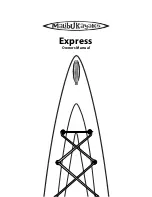
CHAPTER 3
PROPULSION SYSTEM
- 17 -
34z
3.10 STOPPING
1. Place the remote control lever in neutral.
2. Operate the engine at idle speed for several minutes to allow the turbocharger and
engine to cool.
3. Turn the key switch to the "OFF" position.
EMERGENCY STOP SWITCH See pic in 3.8. This is used to stop both engines simultaneously
in emergencies such as man overboard or tangled propeller. There is another emergency stop
button on Vessel Interface Panels (VIP) located in the cockpit floor locker forward of the engines.
Starting after Emergency Stop with engine in Gear
(See SOM 6)
Avoid stopping the engine if the sterndrive is in gear. If the engine does stop with the sterndrive
in gear such as when pushing the Emergency Stop switch:
(1) Push and pull repeatedly on the remote control handle until the handle returns to the
neutral detent position. This may take several tries if the power package was operating
above idle RPM when the engine stopped.
(2) After the handle returns to the neutral detent position, turn the key switches to OFF for at
least 30 seconds.
(3) Resume normal starting procedures.
Make sure to turn OFF Engine Battery Switches under the electrical panel when leaving the boat.
3.11
OPERATION
Engine trouble can arise if the engine is operated for a long time under
overloaded conditions at max RPM. Recommended “Max Cruising Speed” is at least 10% below
full throttle. While running, pay attention to the engine data on the LCD display. A significant
change in temperature, oil pressure, or voltage should be investigated immediately, before the
engine is damaged.
OIL PRESSURE – Normally between 30 psi when idling to 93 psi
COOLANT TEMPERATURE – Normally between 176 and 185 degrees F.
OIL TEMPERATURE – Normally 192 degrees F.
CHARGING – Normally about 14 Volts when underway.
Depending on hull structure and engine installation, engine and hull resonance may be greater at
some speeds than others. This is normal and you will learn to pick the sweet spots. If you hear
any abnormal sounds, stop the engine and inspect.
If any warning lights or buzzers/horns activate, stop the engine immediately.
Determine the cause and repair the problem before continuing to operate.













































